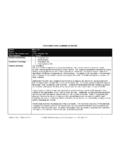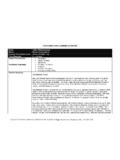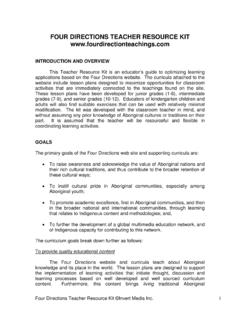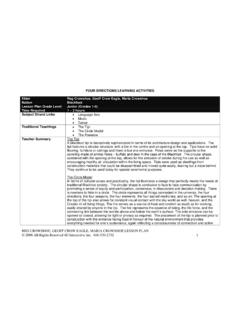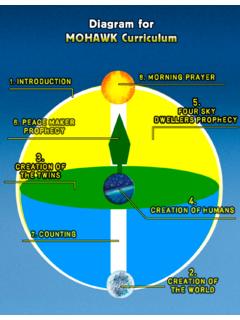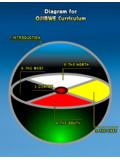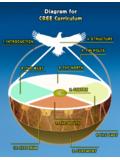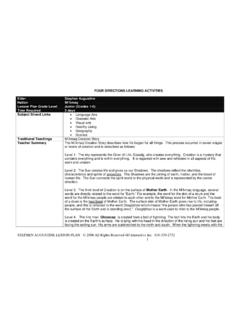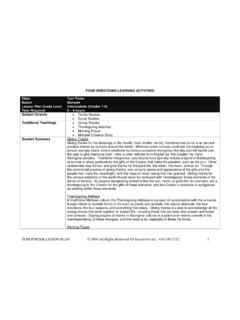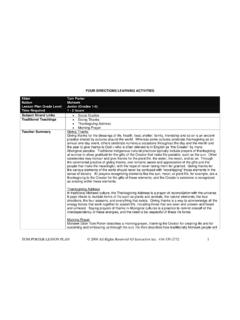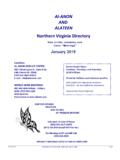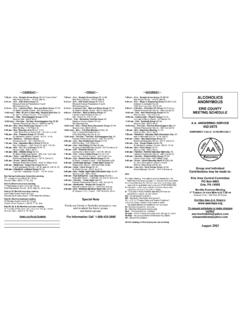Transcription of FOUR DIRECTIONS LEARNING ACTIVITIES
1 LILLIAN PITAWANAKWAT LESSON PLAN 2006 All Rights Reserved 4D Interactive Inc. 416-530-2752 1 four DIRECTIONS LEARNING ACTIVITIES Elder Lillian Pitawanakwat Nation Ojibwe/Potawotami Lesson Plan Grade Level Senior (Grades 10-12) Time Required 3 4 hours Subject Strand Links Language Arts Religious Studies Key Concepts The Medicine Wheel Tradition The four DIRECTIONS The Centre of the Wheel The four Sacred Medicines Death and Remembrance The Strawberry Teaching Summary The Medicine Wheel Medicine Wheels made of stones arranged on the Earth have been found in various places throughout North America, marking places of special significance, such as places of energy, ceremony, meeting, meditation, teaching, and celebration.
2 Some estimate that there were about 20,000 medicine wheels in North America before European contact occurred. Some Medicine Wheels on the prairies have been found to be 5,000 years old or more. The Medicine Wheel is, in essence, a circle divided into four parts, representing the four DIRECTIONS , which relate to and counterbalance one another to form a whole; this symbol is used to represent Aboriginal philosophy on the meaning of life. Medicine Wheels are not necessarily a tradition belonging to all North American Aboriginal peoples; however, many Aboriginal groups have some variation of the Wheel.
3 Nevertheless the traditional knowledge and views of the various first peoples of North America typically share a circular model of thinking. As a whole, the Medicine Wheel represents the relationships between various elements of the world, both seen and unseen, and emphasizes how all parts of the world and all levels of being are interrelated and connected through a life force originating in the creation of the universe. According to the Ojibwe, there are seven teachings within each quadrant of the wheel and each has sub-teachings as well. All parts of the wheel are important, and depend on each other in the cycle of life; what affects one affects all.
4 For this reason, the Medicine Wheel teaches that harmony, balance and respect for all parts are needed to sustain life. LILLIAN PITAWANAKWAT LESSON PLAN 2006 All Rights Reserved 4D Interactive Inc. 416-530-2752 2 Tradition Tradition is knowledge or ways of doing things that are taught by older people - or Elders - who have worked and studied many years with Elders that came before them to understand the traditions. The four DIRECTIONS Each quadrant of the Medicine Wheel represents one of four cardinal DIRECTIONS . The Ojibwe believe that the East represents the springtime and the beginning of all life, changing from spirit to human; the journey starts there.
5 The journey continues to the South, the summer stage, to the West, the death stage, and then to the North, the rebirth stage. This cycle continues in a clockwise motion around the Medicine Wheel, following the rising and setting of the sun, with the four DIRECTIONS serving as primary directional, or guiding, forces. The Centre of the Wheel The centre of the Medicine Wheel symbolizes the self in balance on its life journey, from the perspective of traditional Aboriginal philosophy. The central place of the Medicine Wheel is where one seeks to develop a holistic vision and understanding of creation and connection to all things.
6 The Ojibwe believe that the Centre of the Wheel is represented by a flame and it is our responsibility to nurture this fire by reconciling conflicts with others and making peace within ourselves. Through reflection, meditation, awareness, acceptance and surrender, we are able to live balanced and whole lives. The four Sacred Medicines To give thanks each day to those things that are needed to sustain life, traditional Ojibwe people take a small handful of tobacco and place it in a clean place on the earth or on the shore of a lake. In this way, the Ojibwe thank nature, Creation, for giving the breath of life.
7 Tobacco is represented by the East on the Medicine Wheel. Cedar is used as a traditional medicine often prepared as a tea to cleanse the body and mind and spirit of things not needed on life s journey. Cedar is represented by the South on the Medicine Wheel. Sage is represented by the West on the Medicine Wheel and is used for cleansing as well, burnt to use the smoke as a wash over the body. LILLIAN PITAWANAKWAT LESSON PLAN 2006 All Rights Reserved 4D Interactive Inc. 416-530-2752 3 Sweet grass is represented by the North on the Medicine Wheel and is used to invite positive energy.
8 Death and Remembrance Among other things, the north direction of the Medicine Wheel is representative of the winter season, the elder stage of life, and the colour white. Just as plants transform themselves through the changing of the seasons to end life in winter, the stages of life proceed from infancy through to adulthood and death. Traditional Ojibwe people believe, however, that death is but one stage of the cycle of life, as it is not the end; there is no end. The life force is continuous beyond the moment to death through transformation into spirit. The white of the snow is kin to the white of the death spirit and the death of the physical body is kin to the birth of the spirit.
9 Veneration of the spirits is important to maintain awareness of one s place in the cycle of life and to experience the fullness of self; this is done through various ceremonial practices. The Strawberry Teaching In the Strawberry Teaching two brothers mischievously play at wrestling, against their parents wishes. Following the accidental death of one of the boys, the survivor is overcome with grief and ashamed to admit his role in his brother s death. After years of grief and anger, the surviving brother is surprised to discover a strawberry plant growing on his brother s grave.
10 As the fruit matures it transforms from a tiny white bud to a beautiful red, luscious fruit, shaped like a heart. Eating this fruit restored his joy in life again and allowed him to release his guilt and shame. Change and healing took place not from the head, but from the heart following acceptance of his brother s death. Learner Objectives Knowledge/Understanding: To identify the Ojibwe as an Aboriginal people with traditional beliefs To develop awareness of the natural environment through the identification of the four Cardinal DIRECTIONS To identify the Centre of the Medicine Wheel as symbolic of balance and harmony To relate the continuum of life, growth, death and rebirth to the Medicine Wheel To relate the practice of remembrance of the dead as significant to honoring all the stages of life along with their gifts and teachings To become familiar with the meanings of the terms Medicine Wheel.
